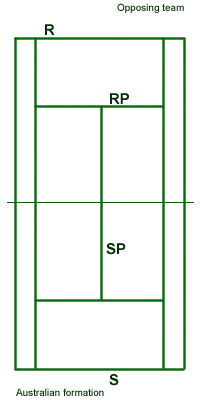The obvious opening down-the-line in the AF makes it a tempting serve return choice. In this case, the ball must be taken early by the receiver and hit aggressively.
Another option would be chipping the return down-the-line toward the intersection of the service line and singles sideline. The idea is to hit it low so that either the opposing baseline player or net player would be forced to hit it up if they get to it. That would please the receiver’s net partner very much, setting him up for a high put-away volley.
Other returning options would be the cross-court lob or hitting aggressively to the middle of the court.
Let’s take a look at some of the situations that must be taken into consideration when returning against the Australian Formation:

1. The receiver’s partner should position himself a little closer to the sideline – that gives the receiver an unobstructed view of the opposing up player. Also, in anticipation of a poach, the receiver’s partner should wait on the service line ready to defend. He should not station there after the point starts, but move up once the service return has been made safely.
2. The receiver’s partner positioning wide, transmits to the opposing team the message that the returner is considering the wide cross-court return. That makes the AF team take into consideration the wide angles that they need to cover.
3. The serve return should be done aggressively. Considering that the AF team will be switching positions right after the serve is made, hitting the return hard will give them less time to get set and balanced for the next shot.
4. Watch for the server’s partner trying to poach. His main job is to poach the return. So the receiver’s partner, by staying further back (service line at least), should expect the opposing up player’s attack.
5. If the server is moving up, aim the return at his feet (no man’s land).
6. Again, I’d like to emphasize that the serve return should be solid. Take the ball early and don’t give the opposing team time to set up.